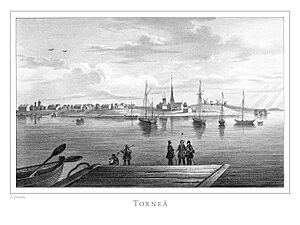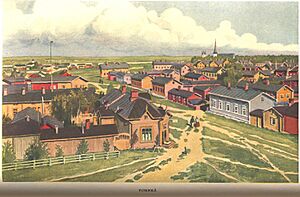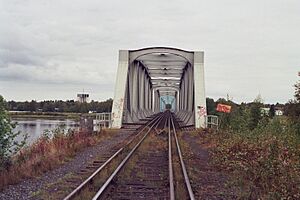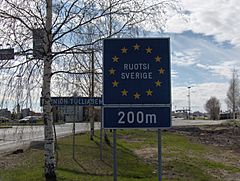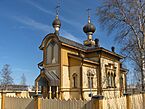Tornio facts for kids
Quick facts for kids
Tornio
Torneå
Duortnus Tuárnus |
||
|---|---|---|
|
Town
|
||
| Tornion kaupunki Torneå stad |
||
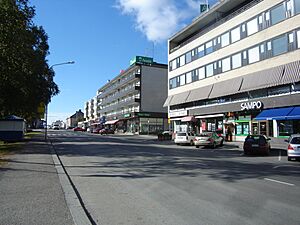
Central Tornio
|
||
|
||

Location of Tornio in Finland
|
||
| Country | ||
| Region | Lapland | |
| Sub-region | Kemi-Tornio | |
| Charter | 1621 | |
| Area
(2018-01-01)
|
||
| • Total | 1,348.83 km2 (520.79 sq mi) | |
| • Land | 1,188.71 km2 (458.96 sq mi) | |
| • Water | 161.59 km2 (62.39 sq mi) | |
| Area rank | 60th largest in Finland | |
| Population
(2023-12-31)
|
||
| • Total | 21,018 | |
| • Rank | 48th largest in Finland | |
| • Density | 17.68/km2 (45.8/sq mi) | |
| Population by native language | ||
| • Finnish | 96.1% (official) | |
| • Swedish | 0.5% | |
| • Sami | 0.1% | |
| • Others | 3.4% | |
| Population by age | ||
| • 0 to 14 | 16.9% | |
| • 15 to 64 | 58.9% | |
| • 65 or older | 24.2% | |
| Time zone | UTC+02:00 (EET) | |
| • Summer (DST) | UTC+03:00 (EEST) | |
Tornio is a city and municipality located in Lapland, Finland. It's special because it forms a cross-border "twin city" with Haparanda in Sweden. This means the two cities are right next to each other, separated by a border.
The municipality covers about 1,348.83 square kilometres (520.79 sq mi), with some of that being water. Around 21,018 people live there. Tornio mainly speaks Finnish. Even though it's close to Sweden, most people in Tornio speak Finnish as their main language.
Contents
History of Tornio
The area around the Torne River has been lived in for a very long time. People have been here since the last ice age ended. Scientists have found 16 old settlement sites in the area. This shows that people have lived here for thousands of years.
Before the 1800s, people in the countryside spoke Finnish and Kemi Sámi. This was a language from the Eastern Sami group. However, people living in the town itself mostly spoke Swedish.
The name 'Tornio' comes from an old Finnish word. It means "war spear." The city was named after the river. In Swedish, the name became Torneå, which comes from Torne å, another name for the river.
How Tornio Started
Tornio officially became a town on May 12, 1621. This happened when King Gustavus Adolphus gave it a special permission called a "charter." The town was built on an island called Suensaari. At that time, Tornio was the most northern city in the world!
It got its charter because it was a very important trading center in Lapland. For a while, it was the richest town in Sweden. Even with all the trade, the town's population stayed small, usually just over 500 people.
Exploring the Arctic
In the 1700s, many explorers came to Tornio. They wanted to study the Arctic region. One famous expedition was led by Pierre Louis Maupertuis from France. He came to measure the Earth's shape. His measurements helped prove that the Earth is a bit flat at the poles. The church spire in Tornio was an important landmark for his measurements. This church was built in 1686.
Changes and Challenges
Over time, the trade in Lapland started to slow down. Also, the land around the river began to rise. This made the river too shallow for big boats. So, the harbor had to be moved twice.
The biggest change happened in 1808 during a war between Sweden and Russia. Russia took over Finland. The border was drawn right through the Muonio and Tornio rivers. This split Lapland into two parts, which hurt trade. Tornio ended up on the Russian side of the border. To make up for losing Tornio, the Swedes built a new village called Haaparanta (now Haparanda) on their side. Tornio then became a city where only Finnish was spoken.
During the time it was part of Russia, Tornio was a quiet town with a military base. Trade only picked up during the Crimean War and World War I. During World War I, Tornio and Haparanda were very important. They had the only railway link connecting Russia to its allies in the West. Famous leader Vladimir Lenin even passed through Tornio when he returned to Russia in 1917.
Modern Tornio
After Finland became independent in 1917, Tornio became quieter again. However, its population slowly grew. The town was not involved in the Finnish Civil War. But it did see some intense fighting at the start of the Lapland War against Nazi Germany. Finnish forces quickly took back the town. This likely saved it from being burned down, unlike many other towns in Lapland. Because of this, the old wooden church from 1686 is still standing today.
After World War II, Tornio found new ways to create jobs. A local brewery called Lapin Kulta and a stainless steel factory called Outokumpu became very successful. Tourism, especially because of the border, has also grown. Tornio is also a center for learning in Western Lapland. It has a vocational college and a university of applied sciences.
Tornio and Haparanda are still very close. They are even thinking about merging and being called TornioHaparanda or HaparandaTornio. They are building a new town center right on the international border. They also share some city services and even a golf course that crosses the border! The IKEA store in Haparanda has signs in both Finnish and Swedish, and prices are shown in two currencies.
Sports in Tornio
Tornio has a strong sports scene.
- Tornion Palloveikot is a bandy club. Bandy is a sport similar to ice hockey, played with a ball. This club has won the Finnish championship many times. They play their home games in Haparanda, just across the border in Sweden.
- Tornion Pallo -47 is the main association football (soccer) club in the city.
Some famous athletes from Tornio include:
- Teemu Tainio, a well-known football player and manager.
- Jesse Puljujärvi, an ice hockey player who grew up in Tornio.
- Ville Pokka, another ice hockey player born and raised in Tornio.
The border between Finland and Sweden actually runs through the golf course on the west side of the city!
Climate in Tornio
Tornio has a subarctic climate. This means it has long, cold winters and short, mild summers. The nearby sea makes the winters a little less harsh.
Even though Tornio is far north, it experiences "polar day" for about 13 days in June. This means the sun stays above the horizon for 24 hours a day. However, it does not have a "polar night," where the sun stays below the horizon all day.
| Climate data for Haparanda (adjacent to Tornio; 2002–2020; extremes since 1901) | |||||||||||||
|---|---|---|---|---|---|---|---|---|---|---|---|---|---|
| Month | Jan | Feb | Mar | Apr | May | Jun | Jul | Aug | Sep | Oct | Nov | Dec | Year |
| Record high °C (°F) | 8.4 (47.1) |
8.0 (46.4) |
11.8 (53.2) |
18.5 (65.3) |
28.8 (83.8) |
31.4 (88.5) |
33.6 (92.5) |
31.1 (88.0) |
24.0 (75.2) |
17.0 (62.6) |
11.5 (52.7) |
7.2 (45.0) |
33.6 (92.5) |
| Mean maximum °C (°F) | 2.5 (36.5) |
3.4 (38.1) |
7.5 (45.5) |
12.7 (54.9) |
22.3 (72.1) |
25.2 (77.4) |
27.1 (80.8) |
24.6 (76.3) |
18.7 (65.7) |
11.8 (53.2) |
6.4 (43.5) |
3.7 (38.7) |
28.1 (82.6) |
| Mean daily maximum °C (°F) | −5.9 (21.4) |
−5.1 (22.8) |
−0.3 (31.5) |
5.4 (41.7) |
12.3 (54.1) |
17.8 (64.0) |
21.1 (70.0) |
18.7 (65.7) |
13.3 (55.9) |
5.6 (42.1) |
0.4 (32.7) |
−2.4 (27.7) |
6.7 (44.1) |
| Daily mean °C (°F) | −9.8 (14.4) |
−9.1 (15.6) |
−4.9 (23.2) |
1.1 (34.0) |
7.4 (45.3) |
12.9 (55.2) |
16.5 (61.7) |
14.4 (57.9) |
9.4 (48.9) |
2.4 (36.3) |
−2.4 (27.7) |
−5.8 (21.6) |
2.7 (36.8) |
| Mean daily minimum °C (°F) | −13.6 (7.5) |
−13.1 (8.4) |
−9.5 (14.9) |
−3.3 (26.1) |
2.5 (36.5) |
8.0 (46.4) |
11.8 (53.2) |
10.1 (50.2) |
5.5 (41.9) |
−0.8 (30.6) |
−5.1 (22.8) |
−9.1 (15.6) |
−1.4 (29.5) |
| Mean minimum °C (°F) | −27.6 (−17.7) |
−27.3 (−17.1) |
−22.3 (−8.1) |
−12.1 (10.2) |
−4.3 (24.3) |
1.8 (35.2) |
5.3 (41.5) |
2.0 (35.6) |
−2.5 (27.5) |
−10.1 (13.8) |
−16.0 (3.2) |
−21.5 (−6.7) |
−29.7 (−21.5) |
| Record low °C (°F) | −40.8 (−41.4) |
−41.7 (−43.1) |
−37.5 (−35.5) |
−26.0 (−14.8) |
−12.0 (10.4) |
−2.0 (28.4) |
0 (32) |
−3.0 (26.6) |
−9.0 (15.8) |
−23.0 (−9.4) |
−32.3 (−26.1) |
−38.0 (−36.4) |
−41.7 (−43.1) |
| Average precipitation mm (inches) | 56.5 (2.22) |
44.9 (1.77) |
35.8 (1.41) |
32.4 (1.28) |
45.5 (1.79) |
52.8 (2.08) |
60.7 (2.39) |
57.2 (2.25) |
64.8 (2.55) |
59.2 (2.33) |
68.9 (2.71) |
63.6 (2.50) |
642.3 (25.28) |
| Average extreme snow depth cm (inches) | 47 (19) |
67 (26) |
76 (30) |
62 (24) |
7 (2.8) |
0 (0) |
0 (0) |
0 (0) |
0 (0) |
4 (1.6) |
13 (5.1) |
26 (10) |
77 (30) |
| Source 1: SMHI Open Data | |||||||||||||
| Source 2: SMHI Monthly Data | |||||||||||||
Getting Around Tornio
Tornio is an important place for travel. The railway systems in Finland and Sweden are different. So, at Tornio, trains need special equipment to switch between the two systems. Finnish Railways (VR) offers passenger service from Tornio-East station a few times a week.
Kemi-Tornio Airport is near Tornio, about 18 kilometers away in Kemi. The Port of Tornio is a cargo port. It's next to the Outokumpu steel factory.
Highway 29 is part of European route E8. The section between Keminmaa and Tornio is the world's most northern motorway. Tornio is also where European route E4 ends.
Famous People from Tornio
- Jesse Puljujärvi, an ice hockey player.
- Kalle Palander, an alpine skier.
- Saku Mäenalanen, an ice hockey player.
- Teemu Tainio, a football player.
- Ville Pokka, an ice hockey player.
- Ville Pörhölä, an athlete and Olympic winner.
Twin Towns and Sister Cities
Tornio has "twin town" or "sister city" relationships with several other cities around the world. This means they share cultural ties and friendly connections.
 Devizes, England, United Kingdom
Devizes, England, United Kingdom Hammerfest, Norway
Hammerfest, Norway Ikast-Brande, Denmark
Ikast-Brande, Denmark Kirovsk, Russia
Kirovsk, Russia Szekszárd, Hungary
Szekszárd, Hungary Vetlanda, Sweden
Vetlanda, Sweden
Images for kids
See also
 In Spanish: Tornio para niños
In Spanish: Tornio para niños




